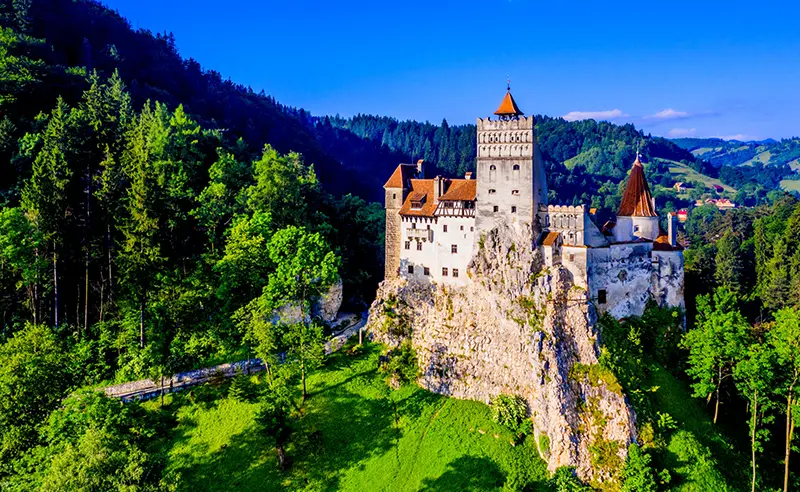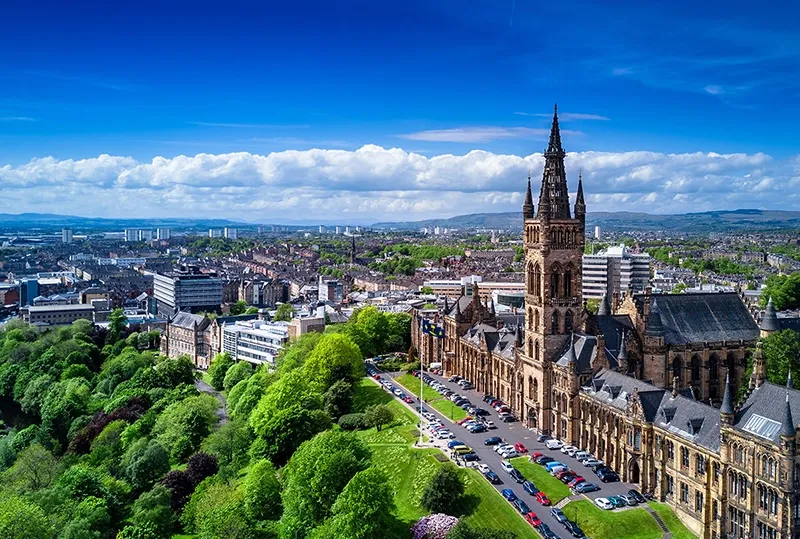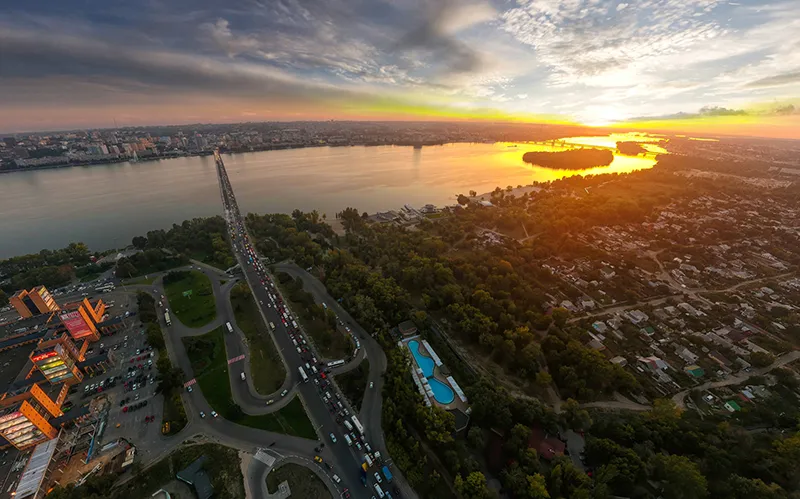Transylvania is a historical region in the center of Romania, known for its medieval castles, picturesque Carpathian Mountains and legends about Count Dracula. The rich culture, the mixture of Romanian, Hungarian and Saxon heritage make this region unique. Ancient fortresses, Gothic cathedrals and colorful villages have been preserved here, attracting travelers from all over the world.
Romania’s Historic Region
The historic region of Transylvania occupies the entire plateau of the same name, with average altitudes of 300-500 meters, through which the tributaries of the Danube flow.
The highest spurs of the Carpathian Mountains are located in the south of Transylvania. Many mountain chains stretch inland from the mountains on the border with Transylvania. They diverge in all directions and are cut by narrow and short valleys in the form of hollows. In the very center of the region lies the Mezeszeg, a fertile hilly area, one of the most relatively flat parts of the region.
Transylvania has many small rivers, all of which belong to the Danube River basin. The river channels are deep and wide, and the elevation difference between the source and the mouth is great. There are also many small deep lakes, nicknamed “sea eyes”. This area is rich in healing mineral springs.
Transylvania is located in the south of Eastern Europe, but the climate here is rather harsh, which is explained by its relatively high position above sea level and the presence of mountain chains. In the mountains winter lasts until May, spring is mild, summer is warm, but in the south rains and floods are not uncommon.
Depending on the altitude, there are three natural zones: mixed forests (up to 1000 m), higher – coniferous forests and alpine meadows (from 2000 m). The forests of Transylvania are predominantly of mixed type, covering 40% of the territory of the region and represented by spruce, pine, beech, oak, alder. In total there are up to 2500 plant species, of which 70 are endemics.
At present, the core of Transylvania consists of nine regions of modern Romania.
The oldest traces of human presence in this territory date back to the Paleolithic period. The later inhabitants are evidenced by fragmentary data from the 5th century B.C., which tells about the Dacians, a group of Thracian tribes. They were mentioned in their works by the ancient Greeks: historian and geographer Strabo and philologist Isychius of Alexandria.
Dacians were a warlike people, made constant raids on their southern neighbors – the Romans. They so annoyed the latter that Emperor Trajan waged a war of annihilation against them. Dacians he defeated, their capital Sarmizegetuzu captured, and since II century AD their land became a province of Roman Dacia.
The Romans seized the gold mines of Transylvania, and the region of Dacia was considered one of the richest in the Roman Empire at the end of II – beginning of III century A.D. This continued until Transylvania was captured by the Goths in the middle of III century A.D. The Romans left Dacia, and its cities fell into decline.
There is controversy over the origin of the Romanians. According to one version, they are descendants of the Romanized Dacians who survived in the region.
Since the XII century Transylvania, the core of Dacia, was conquered and became part of the Hungarian kingdom. It was settled by Hungarians, Vlachs and Germans. In the middle of the 16th century, Transylvania – by then a principality – came under the rule of the Ottoman Turks.
In the following centuries, control over Transylvania frequently passed from Hungary to Austria and vice versa, until in the early 20th century it became Romanian territory under the 1920 Treaty of Trianon (not counting the period 1940-1945, when the northern part of Transylvania was part of Hungary).
Today, the central territory of Dacia is located within the sovereign Republic of Romania, and a number of historical peripheral regions are within Serbia, Hungary, Ukraine and Moldova.
The origin of the name “Transylvania” has Latin roots, from “trans” for and “silva” forest. That is, a fallow forest. The Hungarian name Erdei, or forest, and the Romanian word Ardial, derived from it, are also used for the historical region of Transylvania. The Germans called it Semigradie – after the name of the castle Sibinburg, or “castle on the river Sibin”. There are dozens more names of Transylvania, which were given to it by the peoples living there.
People aspired to Transylvania because this region is very rich in minerals, their extraction and realization stimulated the development of cities. The agriculture of Transylvania is very diverse, dominated by cattle breeding, viticulture and winemaking, as well as fruit growing.
This region is also notable for its colorful ethno-linguistic map. Dozens of nationalities live here, the majority of which are represented by those who have settled here for a long time: Romanians, Hungarians and Germans. Romanians occupy mainly the western and southern part of Transylvania, Hungarians the border western part, called Northern Transylvania. Since the end of World War I and the annexation of Transylvania to Romania, the number of Romanians has been steadily increasing, while the proportion of other nationalities has been decreasing. One reason for this is the exodus of non-Romanians from predominantly rural Transylvania and their move to the cities.
Transylvanian Germans are mostly Saxons who came to these places to serve in the army. They are called “Saxons”, although most came here from the Mosel Valley in the mid-12th century, during the German colonization of Transylvania, at the call of the Hungarian King Geza II. The king intended to solve two problems at once: to create a chain of German settlements to protect Hungary from nomads and to develop the iron ore deposits.
After the end of World War II, a significant part of the Romanian Germans left Transylvania for Germany.
The Germans built many defensive structures here, including the town of Schassburg (Sighisoara), which is not only the center of Sak culture in Transylvania, but is also a UNESCO World Heritage Site.
Among other places of interest in Transylvania we should mention Sarmizegetusa – the main military, religious and political center of independent pre-Roman Dacia and the residence of the Dacian kings, including the last of them, Decebal, who ruled here in 86-106 AD. The fortress was one of the six strongholds of Decebal’s defensive system and was destroyed by Roman troops during the Dacian wars. In 1999 it was included in the UNESCO World Heritage List as “The Dacian Fortress in the Orashtie Mountains”.
The change of epochs and peoples had a significant impact on the diversity of architectural styles in the cities of Transylvania.
The process of Christianization of this area was expressed in the construction of majestic cathedrals. One of the examples of such construction is the Roman Catholic Cathedral of St. Michael, the construction of which began in 1350 and lasted for 200 years The cathedral is located in the city of Cluj-Napoca, the administrative center of the county of Cluj and the former capital of the Hungarian part of Transylvania.
In the town of Hunedoara stands the main Gothic monument of the country – the mid-15th century Corvin Castle, where the deposed Vlad III Tepes (1431-1476), the prototype of the mysterious Count Dracula, was imprisoned. Tepes was the lord of Wallachia, a historical region that borders Transylvania. He is credited with cruelties against his enemies and subjects, the authenticity of which, however, is not trusted by many scholars.
General Information
- Location: Eastern Europe, center and northwest of Romania.
- Administrative division: 16 judez (Alba, Arad, Bihor, Bistrica-Năsăud, Brasov, Caras-Severin, Cluj, Covasna, Harghita, Mures, Selage, Sibiu, southern parts of Satu Mare and Maramures, Hunedoara, Timis).
- Languages: Romanian (official), Hungarian, German.
- Ethnic composition: Romanians – 75%, Hungarians – 19%, Germans – 1%, others (Ukrainians, Jews, Serbs, Roma) – 5%.
- Religions: Orthodoxy (Romanian Orthodox Church) – at least 80%, Protestantism – more than 5%, Catholicism – about 5%, others (Islam – up to 2%, Judaism and others), outside denominations – about 5%.
- Monetary unit: leu.
- Major population centers: Cluj-Napoca, Timisoara, Brasov, Oradea, Sibiu, Arad, Târgu Mures, Baia Mare, Satu Mare.
- The largest rivers: Mures, Olt, Somes, Keres, Golden Bystrica.
- External border: Ukraine – in the north, Hungary – in the west, regions of Romania – south and east.
- Area: 100,230 km2.
- Population: 7,221,733 (2002).
- Population density: 72.1 persons/km2.
- The highest point: Mount Moldoveanu (2544 m).
Economy of Transylvania
- 35% of GNP of Romania.
- Mineral resources: natural gas, lignite, iron, gold, lead, manganese, copper, sulphur, mercury, rock salts.
- Industry: chemical, metallurgical, light (textile), food, pharmaceutical.
- Agriculture: plant growing (potatoes, wheat, corn, sugar beet, fruits, viticulture), cattle breeding (cattle and sheep breeding).
- Winemaking.
- Forestry.
- Service sector: tourism.
Climate and weather of Transylvania
- Moderately continental.
- Average temperature in January: -3°С.
- Average temperature in July: +17°C.
- Average annual precipitation: 550 mm.
Attractions
- Mezeszeg Valley;
- Transylvanian Alps;
- Sedmigrad Ore Mountains;
- Ruins of Sarmizegetuza (I-II centuries AD);
- Town Hall Tower (XII c.);
- City of Cluj-Napoca: St. Michael’s Cathedral (XIV-XVI c.), Botanical Garden, museums of arts, historical, ethnographic; Lutheran Church (XIX c.);
- Hunedoara city: Corvin Castle (middle of the XV c.);
- City of Alba Iulia: Museum of Unification (history of Transylvania), Gothic cathedral (XV c.), palaces (XIV-XVIII c.), the oldest museum in Romania, citadel of Charles VI;
- Sibiu city: Brukenthal Palace, Evangelist Church (XIV-XVI c.), St. Mary’s Cathedral (XIV-XVI c.);
- City of Brasov: Central Square, Church of St. Bartholomew (XIII c.), Bran Castle (XIV c.), Black Church (XV c.), Historical Museum, Town Hall (XV c.);
- City of Sinaia: resort (since the end of XIX c.), Peles Castle, Museum of Romania, Sinaia Monastery, Cross of Heroes (XX c.);
- City of Sighisoara: places associated with the name of Count Dracula, clock tower (XIV c.);
- City of Mediash: Prežmer fortress;
- City of Suceava: the throne fortress of the XIV century, the Orthodox monasteries of Sucevica and Moldovica (XVI century).
Fun Facts
- Count Dracula – the popular hero of “vampire” novels – is a figment of the imagination of Irish writer Bram Stoker, who wrote the novel “Dracula” in 1897. In the plot, the main character lives in Transylvania. It has been speculated that the prototype of Dracula was a real historical character – Vlad III Tepes (Dracula).
- The Lutheran Cathedral of St. Mary in Sibiu has the largest church organ in Transylvania and a 73.34 m high church spire, which is the symbol of the city.
- The ruler of Transylvania was Gábor Báthory, the brother of the bloodiest known serial killer, the Hungarian Countess Elisabeth Báthory, who took the lives of between 30 and 650 girls, according to various sources.
- Bran Castle of the XIV century in Brasov is a national monument and one of the symbols of Romania. It is nicknamed “Dracula’s Castle”. There are several other castles with the same nickname in Transylvania.
- In 2005, the Romanian government adopted the Act of Restitution, according to which real estate – including Bran Castle – can be transferred to the former owners. Bran Castle was returned to Dominic von Habsburg, son and heir of Princess Ileana of Romania, the youngest daughter of King Ferdinand I of Romania and his wife Queen Maria.
- The city of Alba Iulia has been known since antiquity, and is mentioned by Ptolemy in one of his works. At the end of the XVIII century, the first library in Romania was opened in Alba Iulia, where the Golden Codex from Lorsa is kept: a manuscript made of parchment, with letters written in gold, created in the VIII-IX centuries.
- Transylvania remains one of the most popular hunting destinations in Europe, as it is home to many wild animals in the mountains.




